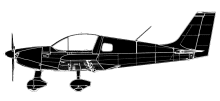
ASN Wikibase Occurrence # 198687
This information is added by users of ASN. Neither ASN nor the Flight Safety Foundation are responsible for the completeness or correctness of this information.
If you feel this information is incomplete or incorrect, you can submit corrected information.
| Date: | Tuesday 29 April 2014 |
| Time: | 23:55 |
| Type: |  Airplane Factory Sling |
| Owner/operator: | Private |
| Registration: | N511NG |
| MSN: | 017 |
| Year of manufacture: | 2011 |
| Total airframe hrs: | 1202 hours |
| Engine model: | Rotax 912 ULS |
| Fatalities: | Fatalities: 0 / Occupants: 2 |
| Aircraft damage: | Substantial |
| Category: | Accident |
| Location: | Daggett, CA -
 United States of America United States of America
|
| Phase: | En route |
| Nature: | Training |
| Departure airport: | Torrance, CA (KTOA) |
| Daggett, CA (KDAG) | |
| Investigating agency: | NTSB |
| Confidence Rating: |
The sport pilot and flight instructor were approaching the destination airport at the conclusion of a night cross-country flight in the light sport airplane. The sport pilot stated that, about 10 miles southwest of the airport, they could clearly see the airport lights and began a visual descent from 5,500 ft mean sea level. During the descent, the airplane collided with terrain about 5 miles from the airport and came to a stop. The sport pilot egressed and called for emergency services.
Postaccident examination of the airframe and engine revealed no mechanical anomalies that would have precluded normal operation. Visual meteorological conditions were present in the area with visibility of 10 miles. Astronomical information showed that moonset had occurred about 3.5 hours before the accident. The accident occurred in a very sparsely populated area of high desert, with no ground lighting. The terrain and dark night conditions would have prevented both pilots from maintaining a visual reference to the terrain.
Examination of the airplane’s Electronic Flight Information System (EFIS) revealed that the aural terrain warning function was not enabled, though the system still depicted a moving map display with terrain information. If the aural terrain warning function had been enabled, the pilots would have been alerted, and action could have been taken in sufficient time to maintain terrain clearance.
Probable Cause: The pilots’ failure to maintain clearance from terrain while operating in dark night, visual meteorological conditions. Contributing to the accident was the pilots’ failure to enable the aural terrain warning system.
Sources:
NTSB
Location
Revision history:
| Date/time | Contributor | Updates |
|---|---|---|
| 19-Aug-2017 14:01 | ASN Update Bot | Added |
Corrections or additions? ... Edit this accident description
The Aviation Safety Network is an exclusive service provided by:


 ©2024 Flight Safety Foundation
©2024 Flight Safety Foundation